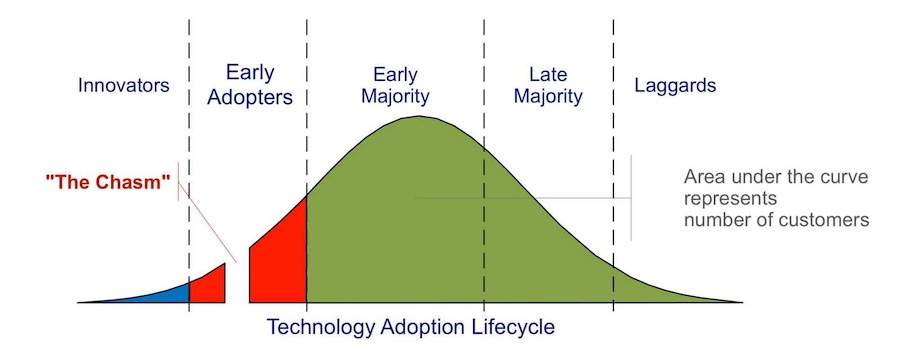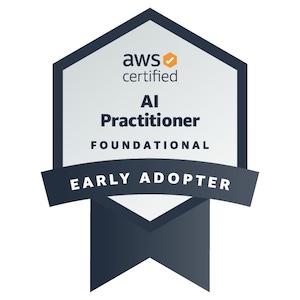Exploring Generative AI at AWS re:Invent 2024: My Journey and Thoughts
Disclaimer: Everything in this post reflects my personal opinions about generative AI.
1. Introduction
As of December 2024, it seems that AWS has finally entered the generative AI race.
It is amusing when people claim AWS has always been there. To be clear, that is not the case. This is the common perception in the community, and I share it.
For the past few years, AWS has been nearly 100% focused on generative AI. While it has been a significant effort to be competitive in this field, and probably a lucrative strategy (now there is also a certification for that - AWS Certified AI Practitioner Certification), this obsession has also been frustrating for many people in the community, and a frequent topic of discussion among AWS users.
At AWS events, for example, generative AI seemed to dominate everything. If a session did not mention it, it almost felt out of place. And if you wanted to present without including generative AI, well… good luck!
The most frustrating aspects for me have been:
- Generative AI is undoubtedly
promising, but how can it be used in a practical manner? How can it truly improve solutions, enhance productivity, and ensure sensitive data remains secure? It seemed like there were significant gaps in addressing these concerns. - Some “generative AI”
content was not truly about generative AI. Instead, it was the same old material with a touch of AI, leaving expectations unmet and resembling clickbait.
That said, AI (and especially generative AI) is undeniably a game-changer. It is transforming lives already and will continue to do so. The real question is: where are we on the technology adoption lifecycle?
After attending re:Invent 2024 (held on December 2-5, 2024), my perception of AWS’s generative AI approach shifted. Perhaps it is because I now understand their offerings better, because they seem more mature and refined, or maybe all of these reasons combined.
What about you? Where are you and what are your thoughts about it?
2. Preparation for re:Invent and personal goals
We knew that AWS re:Invent this year would be a generative AI-focused, immersive week. Knowing that everything at re:Invent 2024 would revolve around generative AI, I decided to prepare by obtaining the AWS Certified AI Practitioner Certification. This gave me a solid theoretical foundation, and I felt ready to learn as much as possible while potentially changing my perception of generative AI.
My goal was to understand the offerings better, get hands-on with AWS tools and services, and learn how to use them to boost my productivity and fill a few gaps I had.
I wanted to know more about 3 topics:
- General aspects
- Explore how to use generative AI to help with the Software Development Life Cycle (SDLC) process (Amazon Q, Amazon Bedrock)
- Explore how to use generative AI within my IDE (Amazon Q Developer)
- Explore how agents work, including using simple approaches and creating your own agent from scratch, using services like Amazon Bedrock and Amazon SageMaker
- Search within my own documents and databases (knowledge bases): Amazon Q Business, Amazon Bedrock, and Amazon SageMaker
- Amazon Bedrock
- Gain hands-on experience integrating Amazon Bedrock via APIs: API Gateway and AWS AppSync
- Explore advanced Amazon Bedrock features
- Amazon SageMaker
- Hands-on experience with SageMaker
- Learn how to train and customize models using Amazon SageMaker
My first two conclusions were (I am not discovering anything really new):
Creating custom solutions can be complex, expensive, and requires expertise. Examples: Training your own model with SageMaker, customizing a model, navigating the numerous features available in both services…- I wanted to use the
simplest approaches, but I always had an eye on the cost. I wanted solutions that were easy to implement yet affordable
Now, I am starting to see the light, and I am understanding everything better, but there is still so much to learn. What I love most about generative AI is how simple it seems on the surface, while underneath, it could be incredibly complex.
3. AWS Generative AI
3.1. Amazon Q
Let’s start with Amazon Q, AWS's generative AI assistant.
Last year, this service was one of the big announcements, and it was exciting but felt like it was launched prematurely. While its potential was clear, the execution did not quite meet expectations. For me it was frustrating.
Now, one year later, things feel different.
3.1.1. Amazon Q Developer
Amazon Q Developer is the evolution of Amazon CodeWhisperer. As of April 30, 2024, Amazon CodeWhisperer officially became part of Amazon Q Developer, so we could say that Amazon Q Developer is the same service, renamed and improved.
At re:Invent 2024, AWS presented many impressive new features for Amazon Q Developer:
- generating/refactoring code
- creating documentation with a single command
- creating unit tests
- performing code reviews
The tool integrates seamlessly into your IDE, which makes it perfect for developers, devops engineers, architects… anyone using the IDE! However, Amazon Q Developer is also available through the AWS Console, CLI, and even integrates with GitLab (currently in preview and quite expensive).
What is the best part for me?
- Amazon Q offers a
free tier(with some limitations), and you candisable the option to share data with AWSso your data is safe.
This IDE integration of Amazon Q Developer is all I was looking for! You will find more information in my specific post about Amazon Q Developer to find why.
3.1.2. Amazon Q Business
There is more about Amazon Q: Amazon Q Business, which uses generative AI to provide tailored insights and capabilities by integrating with organizational knowledge bases and resources.
I tested it in a few workshops, and while it feels incredibly promising, I do have concerns about its potential costs.
Careful with the cost: the user price is very clear, but what about the Index pricing? magic. If you want to use it for your company it should be fine, but for personal use you have better options (and cheaper). Pricing page of Amazon Q Developer
3.2. Amazon Bedrock and Amazon SageMaker: A Different League
And then we have Amazon Bedrock and Amazon SageMaker, two services that operate on a completely different level:
- Amazon Bedrock simplifies access to foundation models for generative AI tasks. It is perfect for
developerswho want to use pre-trained models without delving deep into machine learning. - Amazon SageMaker, on the other hand, is a comprehensive platform for building, training, and deploying ML models. It is aimed at
data scientists and ML engineerswho need full control over the process.
This year, Amazon Bedrock took the center stage at AWS re:Invent, as expected, overshadowing Amazon SageMaker’s spotlight from last year. Both services are incredibly powerful and feature-rich, but I have noticed some overlap in their capabilities. It makes me wonder if AWS might eventually merge them.
The easiest way to integrate generative AI in your application is through an API and connecting it with Amazon Bedrock, and you can do it with a Lambda Function from API Gateway or AWS AppSync. You only have to find your use case, and manage the cost.
I want to mention two announcements for Amazon Bedrock I will explore deeply soon (not here):
- Knowledge Bases for Amazon Bedrock: Allows creation of custom knowledge bases from your data in an easy way. You can also do it with Amazon Q Business (easy but expensive) and with Amazon SageMaker (complex but 100% customizable).
- Agents for Amazon Bedrock: Helps build task-oriented conversational experiences, and can execute multi-step tasks and integrate with external systems. I tested and it is very promising.
4. Hands-on (workshops)
Finally, I would like to share with you workshops about generative AI, so you can explore them by yourself!
- Generative AI (general)
- Using generative AI on AWS for diverse content types: In this workshop, you will use generative AI on AWS to work with various types of contents, including documents, PDFs, videos files, audios files, images, business intelligence, SQL database, graph database, application logs, and streaming data. You will learn on how to leverage generative AI for tasks such as engaging in conversations, posing questions, content analysis, generating summaries, and generating images based on these diverse content sources.
- Amazon Q Developer
- Amazon Q Developer: In this immersive workshop, you will explore the transformative impact of generative AI on the development activities, allowing you to apply next-generation developer experience concepts throughout your SDLC. You will gain practical insights into how generative AI can significantly enhances your efficiency.
- Amazon Q Developer Workshop - Building the Q-Words App: In this workshop you will use Amazon Q Developer to accelerate your software development process.
- Amazon Bedrock
- Amazon Bedrock Workshop: The goal of this workshop is to give you hands-on experience in leveraging foundation models (FMs) through Amazon Bedrock.
- Generative AI at scale: Serverless workflows for enterprise-ready apps: In this workshop, you will gain hands-on experience with building production ready generative AI applications for some common generative AI use cases using Serverless services such as AWS Step Functions, Lambda and Amazon Bedrock.
- Create a Serverless Chatbot Using Amazon Bedrock, Amazon Kendra, and Your Own Data: In this workshop, you use general chat and also use Retrieval-Augmented Generation (RAG) technique to build a generative AI-powered chatbot. A Large Language Model (LLM) in Amazon Bedrock is used to answer your chatbot questions through pre-indexed content.
- Cloud Operations
- Building operational resilience in workloads using generative AI: In this workshop, use AWS managed generative AI services in real-world scenarios to learn how to assess readiness, proactively improve your architecture, react quickly to events, troubleshoot issues, and implement effective observability practices.
- Intelligently Automating Cloud Operations: You can surface insights from best practices, security, fault tolerance, and performance using AWS Trusted Advisor, AWS Health, and Amazon DevOps Guru. Join this workshop to learn how to automate these insights intelligently using AWS services and machine learning tools.
- Much more AI workshops here.
5. Final Thoughts
While AWS’s generative AI journey has been frustrating at times, their progress is undeniable, and I look forward to continue exploring how their tools can reshape the way we work.
It is true that now I understand much better the AWS offering about generative AI, but my general perspective about generative AI has not changed:
we should embrace it in our daily workflows to improve productivity.
But it is also important to remember that not every problem requires generative AI. As always, the key is using the right tool for the right job.
If you are curious to learn more about AWS’s generative AI offerings, I encourage you to explore tools like Amazon Q, Amazon Bedrock, and Amazon SageMaker. They represent the cutting edge of what is possible in cloud-based AI today.
6. Next steps?
I have already written about Amazon Q Developer here, in case you want to know more about it.

